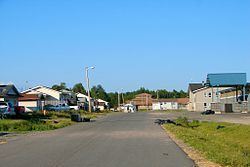Population 367 (2011) | Website www.longlake58fn.ca | |
 | ||
Long Lake 58 First Nation is a Anishinaabe (Ojibway) First Nation band government located in Northern Ontario, located approximately 40 km east of Geraldton, Ontario, Canada, on the northern shore of Long Lake, immediately north of Ginoogaming First Nation and west of the community of Longlac, Ontario. As of January, 2008, their total registered population was 1,248 people, of which their on-Reserve population was 427.
Contents
Map of Long Lake 58, Longlac, ON, Canada
Long Lake Blockade
In late August 1990, members of Long Lake 58 First Nation blocked the Canadian National Railway (CNR) tracks passing through the 537-acre (217.3 ha) Long Lake 58 Indian reserve. The blockade was mounted both to support the Indian stand during the Oka crisis and to draw attention to the fact that the community's traditional lands have never been the object of treaty negotiations with the Crown.
The First Nation maintains the key requirements of the Royal Proclamation of 1763 have never been met by the governments of Ontario and Canada making the CNR Crown Corporation one of a number of trespassers on the community's unceded hunting ground. Because of the Crown's failure to deal with the community in the making of both the Robinson Superior Treaty in 1850 and in Treaty 9 in 1905, the citizens of Long Lake 58 were never able to negotiate a fair apportionment of land for their reserve. The Canadian government maintains that the First Nation ceded their lands to the Crown at the 1850 Robinson Superior Treaty.
In the course of the blockade Long Lake 58 leaders demanded that officials of the Crown, including those overseeing the CNR, must show evidence to prove the legal basis for non-Aboriginal claims to the territory in question. The leadership asserted the unfairness of the principle that the onus of proof always lies with the Indigenous peoples to demonstrate the basis of their land claims. In the course of the dispute the leadership also pointed to the contradiction between the government's position that Long Lake 58 lands have been ceded in the 1850 treaty covering the northern watershed of Lake Superior whereas the community itself is situated in lands naturally drained by rivers flowing northward into Hudson Bay. Regardless of land ownership clearcutting, the spraying of vast tree farms with toxic pesticides and herbicides, and overfishing have left the community's traditional lands polluted and incapable of supporting hunting, trapping and other forms of traditional practice. Moreover, the community's town site had been relegated to a swampy lowland because the CNR tracks and the train yard on the reserve command the high ground of the Indian Reserve.
Throughout this episode the blockade's elder statesman, Rayno Fisher, encouraged those in the protest camp to heed his interpretation. This experienced trapper extorted. "We're not trespassing the CNR, the CNR has been trespassing us for 75 years." Elder Frances Abraham also provided inspirational leadership throughout ten-day blockade. When Indian OPP officials arrived on the reserve to read out in the Anishinaabe language an injunction obtained by the CNR, Abraham emplored, "Why do we always have to show the proof that our land has been taken but those who stole our land never have to prove anything." No charges pressed by the Crown against the protesters suggests the veracity of Mr. Fisher's characterization. Long Lake 58's blockade of the CNR main line was backed up by simultaneous blockades of the Canadian Pacific Railway's main line led by members of Ojibways of the Pic River First Nation, Pic Mobert First Nation, and Pays Plat First Nation further to the south. Of all the actions during the Indian summer of 1990 the train blockades initiated by Long Lake 58 in northern Ontario impacted most seriously on transnational flows of commerce.
Governance
The leadership of the First Nation is determined through the Act Electoral System. The current Chief is Veronica Waboose, who is serving along with twelve Councillors: Judy Desmoulin, Scott Desmoulin, Max Finlayson, Narcisse Kakegabon, Patrick Kakegabon, Anthony Legarde, Herbert Legarde, Frank Onabigon, Arthur Shebagabow, Rosanna Shebagabow, Ervin Waboose Jr. and Mary Waboose.
The First Nation is a member of Matawa First Nations, a Regional Chiefs Council.
Services
Government services are provided by the First Nation, the Matawa First Nations and by the Nishnawbe Aski Nation. Services include:
